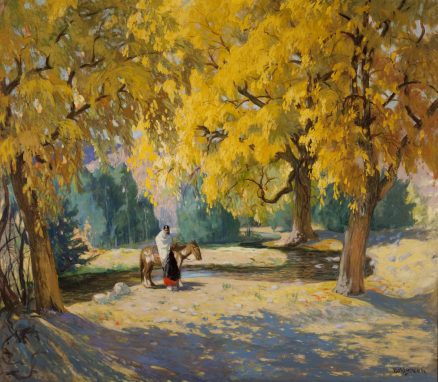- Categories
- Landscapes
- Zoom in on Artwork
- Print Page
- Email Page to Friend
Charles Dahlgreen painted Rendezvous during one of several working visits he made to Taos, New Mexico, where a community of artists, many with ties to Chicago, had been creating images of the region’s native inhabitants and distinctive landscape since the 1910s. This painting emphasizes the striking gold foliage of cottonwood trees, which screen the mountainous landscape in the distance. In the middle ground, near a meandering stream, two American Indians—a white-draped man on a horse and a standing woman cloaked in black over a bright-red skirt—provide a focus for the composition. Playing off the golden tones of the sun-drenched scene are cool shadows cast by the trees in the foreground. In this painting as in the work of many conservative landscape artists of the interwar period, hallmarks of impressionist technique combine with pictorial conventions of representation—notably a marked illusion of spatial depth, reinforced in Rendezvous by the receding stream that leads the eye deep into the scene.
The genesis of Rendezvous is well-documented. On his first trip to Taos, in 1931, Dahlgreen painted a large cottonwood in the glowing tones of autumn, which earned the Ball Purchase Prize of $1200 at the Hoosier Salon the following year. Inspired to paint more such scenes, the artist returned to Taos in 1932. As he recalled in his unpublished reminiscences:
I had sold my old Cottonwood and got a commission to paint another one something like the Cottonwood. When I got to Taos I engaged the same two Indians but this time including a horse. I had already formed a picture in my mind, of just what I was going to paint. Not to have a duplicate of the first picture I had to find a composition from a different angle. I found that the tree was not quite as colorful as it was the year previous, yet it made a beautiful setting for my picture. I finally got the horse in place with the Indian on its back, and his squaw standing by the side of the horse. After I had it finished, I must have a title to the picture . . . . It reminded him [sic] of a rendezvous and so it was called Rendezvous.i
Dahlgreen went on to make four related works: The Proposal, Homeward Bound, and Reminiscence, which he exhibited with The Old Cottonwood as a series of four, and Refreshment (circa 1931–1935; formerly Powell and Barbara Bridges Collection). Dahlgreen insisted on the importance of painting landscapes on site, and he worked from a truck converted to serve as a mobile studio. Yet a surviving photograph of the male model for The Proposal, likely taken by the artist, suggests that he may have worked on his paintings, including Rendezvous, at least partly indoors.
Wendy Greenhouse, PhD
Donated by M. Christine Schwartz to Oak Park River Forest History Museum, Oak Park, Illinois, in 2022
i Charles W. Dahlgreen, MS Autobiography, p. 241, in Charles Dahlgreen Papers, Archives of American Art, microfilm reel 3954, frame 302.
